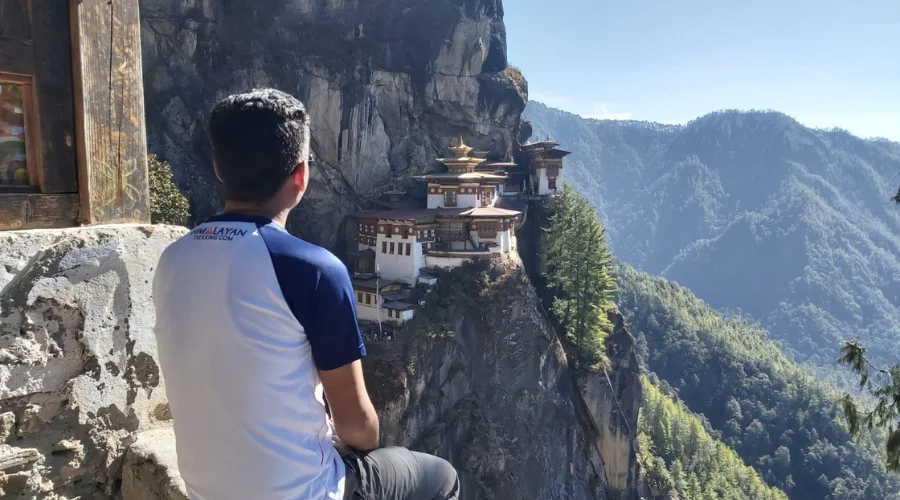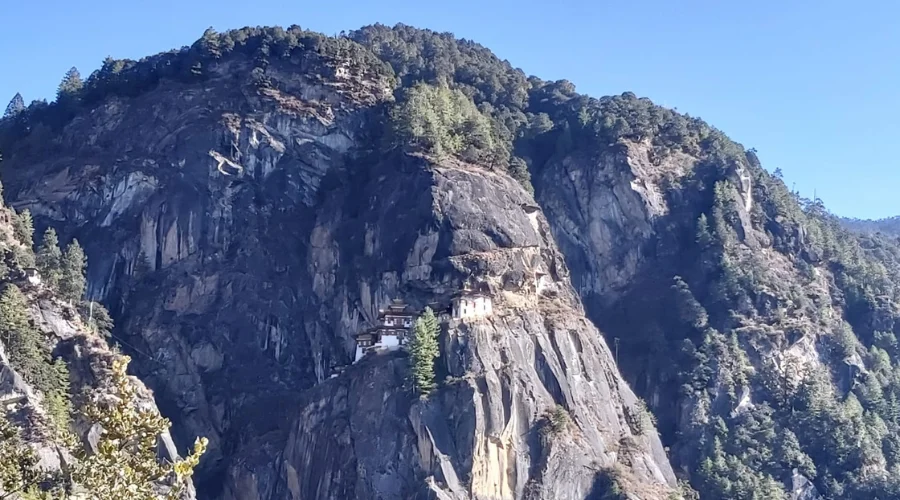Paro Taktsang Monastery is one of the best places to visit in Bhutan. One should not miss it. Bhutan’s Taktsang Monastery, known to most visitors as the Tiger’s Nest, stands among the most important spiritual sites in the country.
The place is beyond its religious role. Visitors to this sacred site experience Bhutan’s spiritual heritage through an adventure that shows the monastery’s historical significance.
Tourists from diverse locations walk each year to see this marvellous structure while they cross pine forests and trail paths.
People across Asia consider Taktsang Monastery one of the essential best places to visit in Bhutan due to its fascinating origins and spiritual folklore, as well as its natural elegance.
Where Is Taktsang Monastery Located?
Taktsang Monastery is located at Paro Valley in Bhutan. Taktsang Monastery, also known locally as Tiger’s Nest Monastery, is located at 10,240 feet above sea level on a steep cliff overlooking Paro Valley, which is 900 meters away.

The Bhutanese identify this place as their most important religious location. Guru Padmasambhava (Guru Rinpoche) arrived at this location riding on the back of a tigress and meditated inside a cave that now forms part of the monastery facilities.
Visitors travel to this site because it provides incredible natural beauty and religious significance while being a prominent spiritual destination.
History Of Taktsang Monastery
This holy sanctuary known as Taktsang Monastery gets its name from Tiger’s Nest after a legendary story emerged. Taktsang Monastery presents itself as a sacred and visually splendid spiritual complex that perches upon the Paro Valley’s cliffs.
The location of Taktsang Monastery is on the mountain, making it stand out as a special destination.
The history of Taktsang can be traced to the year 8th century. Tradition states that the famous Buddhist master Guru Padmasambhava, who was also known as Guru Rinpoche, visited this site. Instead of standard transport, he chose something different.
It is believed that Guru Padmasambhava used a tigress as his aerial transportation to reach this holy location. A magical tale reveals a tigress flew here.
The legend tells how the tigress who changed shape into her magic form became a disciple of Guru Padmasambhava. Guru Rinpoche travelled with his disciples while they both flew toward the cliff, where they entered a nearby cave.
The place became sacred after his prolonged meditation period. Local people accepted that powerful spiritual energy dwelled inside this cave.
Who Built Taktsang Monastery? In 1692, the Bhutanese ruler Tenzin Rabgye constructed the monastery by binding it around this sacred cave. The inception of Taktsang Monastery occurred in this moment. Buddhists consider this site as one of their fundamental spiritual pilgrimage destinations.
The monastery underwent several reconstructive interventions across different time periods since its foundation. The Bhutanese people made a successful effort to reconstruct portions of the monastery after a 1998 fire damaged its structure.
The preservation team successfully restored the monastery to its previous state to maintain its original spiritual virtues.
The sacred place symbolizes the values of both Bhutanese culture and national strength while representing peace. Visitors in thousands of numbers trek through a picturesque forest annually to reach this holy ground.
How To Reach Taktsang Monastery?
Visitors can reach Taktsang Monastery, popularly known as the Tiger’s Nest. Visitors can find the Taktsang Monastery at a close distance to Paro town in Bhutan.
The journey to Taktsang Monastery starts with a flight to Paro International Airport because Bhutan has only one international airport.
A thirty-minute drive from Paro town will bring travellers to the mountain base that marks the start of the hike. From the base camp, visitors must climb uphill to reach the monastery.
Your hiking duration through the trail will vary between 2 to 3 hours based on your walking speed since it measures 4 to 5 kilometres in length. Tourists can enjoy trekking across pine forest landscapes, prayer flag installations, and scenic vistas of Paro Valley during the path.

Travelers can take a break at the middle cafeteria to view the panorama while resting. The following stretch of the trail gets steeper but offers better rewards to hikers. The hire option provides horses to those travellers who need help with the entire trail.
A stone stairway begins from the final stretch, allowing visitors to reach the monastery.
Tiger’s Nest Monastery Facts
- Tiger’s Nest Monastery is located within Paro Valley of Bhutan, which sits on a cliff that rises 900 meters above the ground.
- Buddhists consider this place to be one of the holiest sacred sites in Bhutan because it serves as a significant religious pilgrimage destination.
- A cave was the starting point for constructing the monastery in the 8th century when Guru Rinpoche (Padmasambhava) used it as a place for meditation.
- According to regional beliefs, Guru Rinpoche arrived at the site by riding a magical flying tigress, giving it its nickname, Tiger’s Nest.
- Tenzin Rabgye officially established the monastery in 1692 when he ruled Bhutan.
- A devastating fire engulfed essential areas of the monastery in 1998, although restoration occurred with careful attention to rebuilding the surrounding structures.
- Anyone travelling to the monastery needs to spend 2 to 3 hours hiking through forests along a steep pathway.
- The management at Taktsang Monastery prohibits all forms of camera use because they want the preservation of peace and spiritual sanctity within its walls.
- Four main temples, which include residential buildings together, stand on a narrow cliffside where visitors experience breathtaking views.
Distance to Tiger’s Nest Monastery from Popular Locations in Bhutan
- Paro Town to Tiger’s Nest Base Distance: Approximately 12 kilometres
- Paro International Airport to Tiger’s Nest Base Distance: Approximately 14 kilometers
- Thimphu to Tiger’s Nest Base Distance: Approximately 65 kilometers
- Punakha to Tiger’s Nest Base Distance: Approximately 130 kilometers
- Haa Valley to Tiger’s Nest Base Distance: Approximately 70 kilometers
- Hiking from Tiger’s Nest Base Distance: Approximately 4 to 5 kilometers
Best Time to Visit Paro Taktsang Monastery
The best time to visit the Taktsang Monastery trip for the spring season is between March and May or during the autumn months from September to November.
A trek through the monastery delivers peak exploration conditions throughout spring and autumn since the climate remains pleasant while the skies stay clear and nature displays its best appearance.
Spring:
Spring provides an excellent travel opportunity when the surrounding landscape transforms into a vibrant display of flowers combined with greenery growth.
Visitors can enjoy trekking trails leading to the monastery during spring and autumn because favourable weather and accessible tracks are present.
The seasonal colours enrich the region’s natural beauty, while the picturesque view of the monastery standing on its cliff creates a stunning sight.
Autumn:
Visiting Taktsang becomes appealing during the autumn season. The autumn season brings a clean and cool environment that allows remarkable views between the Himalayan peaks and the monastery buildings.
Due to decreased visitor numbers, people find this seasonal period tranquil for enjoying Bhutan. During autumn, you will experience the area’s maximum natural beauty because the foliage generates a breathtaking visual effect during your travels.
Summer and Winter:
Summer brings hot temperatures from June to August to Bhutan, accompanied by monsoon rainfalls that persist throughout the season. Wet conditions caused by rain make trails very slippery and obscure visibility to the extent that outdoor sports like trekking become less enjoyable.
From December through February, the monastery becomes less popular since most tourists avoid visiting during this period. The snowy landscapes and tranquil atmosphere during the winter months create a special environment those who are prepared for cold temperatures can enjoy through Taktsang monastery hiking.
Importance of Taktsang Monastery for Bhutan
The spiritual connection combined with cultural and national significance makes Taktsang Monastery known as the Tiger’s Nest, the most sacred Buddhist site of Bhutan.
Bhutan identifies Taktsang Monastery as its most revered Buddhist location because it marks the pivotal point of Buddhist entry into the nation.
Legend says that Guru Padmasambhava, known as Guru Rinpoche, arrived at the site with a tigress while he meditated in a cave, which later became part of the Taktsang Monastery.
His journey is thought to have fought against and subdued malevolent beings throughout Bhutan while spreading Buddhist teachings to the region in the 8th century.
The monastery stands as a religious monument that symbolizes faith together with devotion and spiritual enlightenment.
Bhutanese people make spiritual journeys to Taktsang from different parts of the country as they trust that visiting this holy sanctuary will bestow upon them blessings together with sacred powers. Many Bhutanese people dedicate their life to Taktsang Tiger’s Nest Monastery Hike at least one time.
Taktsang Monastery shows the boundaries of Bhutanese religious tradition as well as traditional architecture and cultural heritage. The cliffside construction demonstrates traditional Bhutanese architectural mastery through its sturdy design structure.
Religious festivals known as Tshechu include the performance of prayers and rituals to honour Guru Rinpoche.
The national identity of Bhutan depends on Taktsang Monastery as it represents both spiritual heritage and national independence. Bhutan’s Buddhist core beliefs merge with the central place religion occupies in ordinary living throughout the country.
Taktsang Monastery Entry Fee
The entry fee for Taktsang Monastery (Tiger’s Nest) is 2,000 ($25) Bhutanese Ngultrum (Nu) in March of this year for every adult guest. The fee of 2,000 Bhutanese Ngultrum does not vary between domestic and international travellers.
Bhutan’s cultural heritage sites benefit from this revision because it supports sustainable tourism management along with the preservation of heritage sites.
Visitor Guidelines
Dates set according to the Bhutanese lunar calendar grant exclusive access to Bhutanese citizens who want to visit. Executive periods exist when international visitors cannot access Taktsang Monastery according to Bhutanese regulations.
Entry fees cover the monastery access, but hirers of mules or horses for climbing the trail, along with refreshment purchases, require separate costs.
Taktsang Monastery Fire
In 1998, a destructive fire damaged the structure of Taktsang Monastery, which people refer to as the Tiger’s Nest. Most wooden aspects of the monastery, along with crucial biblical paintings and holy relics, burned down in the flames.
A monk became one of the casualties because of the destructive event. A possible electrical fault, together with warped tapestries from flickering butter lamps, were the probable causes of the blaze.
An urgent conservation effort started after the fire which received leadership from the Bhutanese government. Traditional techniques and materials formed the basis for the restoration that targeted the recovery of the monastery into its previous state.

The reconstruction of the facility was achieved in 2005, which made the site accessible to the public.
The central part of the monastery, preserving the place where Guru Padmasambhava meditated, survived undamaged while the fire raged through its surrounding areas.
The restoration process of the monastery successfully revitalized its physical construction while it strengthened the sacred connection between Bhutan and worldwide Buddhist believers.
Inside Paro Taktsang Monastery
Upon entering the premises of Paro Taktsang Monastery, visitors encounter a sanctuary filled with religious inspiration from the heart of Bhutanese beliefs.
The monastery exists atop a cliff as a site of significant religious value because its existence stretches back to the 8th century.
Paro Taktsang Monastery contains several main temple structures that display detailed Buddhist artwork alongside holy objects and religious sculptures.
Mysterious paintings of Buddhist deities, including Guru Padmasambhava, hang on the walls of the monastery that show the reputed spot where the revered figure meditated in the cave.
The essential religious site within Taktsang is the Dubkhang sanctuary. According to legend, Guru Rinpoche spent three months meditating in this location, which continues to attract Buddhist pilgrims today.
Different temples and chapels occupy each level of the monastery through its system of narrow connecting stairwell pathways. Inside the sanctums, visitors find statues of Lord Buddha together with multiple divine figures and prayer candles as well as butter lamps and incense that enhance the spiritual feeling.
People who visit Paro Taktsang Monastery in Bhutan discover an interior that creates a serene, contemplative atmosphere, which makes their experience wonderfully unique.
Send an Enquiry
Error: Contact form not found.
© 2025 - Himalayan Trekking and Tours (P) Ltd. All Rights Reserved.

